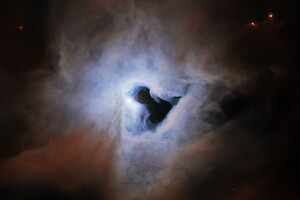The object is located in the Orion constellation.

Scientists obtained a picture using the Hubble telescope an unusual space structure resembling a keyhole. As reported on the website of the observatory, this is the reflection nebula NGC 1999 in the Orion constellation.
It is located near the Orion Nebula – the region of active star formation closest to Earth. NGC 1999 itself is the result of star formation, it was formed from the detritus left over from the formation of a newborn star.
Also read: NASA and SpaceX want to extend the life of the Hubble telescope
Scientists compare chops nebula with fog swirling around the lantern. According to them, such objects emit light only thanks to the “built-in” source. In the case of NGC 1999, that source is the newborn star V380 Orionis, which can be seen in the center of the image.
But the most striking feature of NGC 1999 is the hole in its center, which resembles a keyhole of cosmic proportions.
< p>After scientists first imaged the object in 1999, they believed that this dark spot in NGC 1999 was something called a Bocce globule—a dense, cold cloud of gas, molecules, and cosmic dust that obscures the background light. But further observations made with the help of other observatories showed that this is a region of empty space.
Why such a “hole” formed in the nebula remains a mystery to scientists.
Related video
Previously < strong>the James Webb telescope transmitted to Earth a picture of the Pillars of Creation – one of the most famous structures in the universe, which was “made famous” by the Hubble telescope. In the new image, you can see many stars that are located inside the object.




